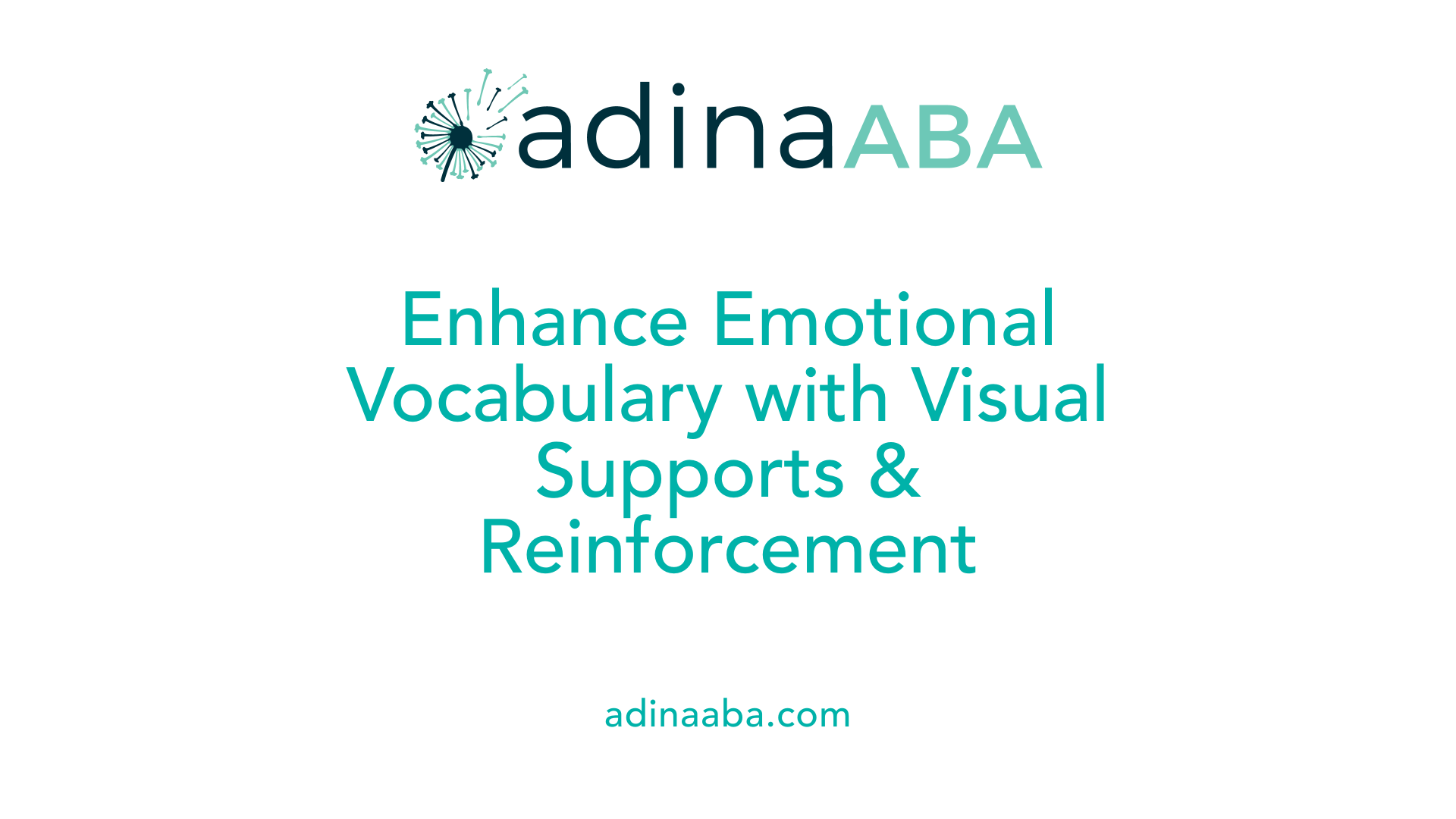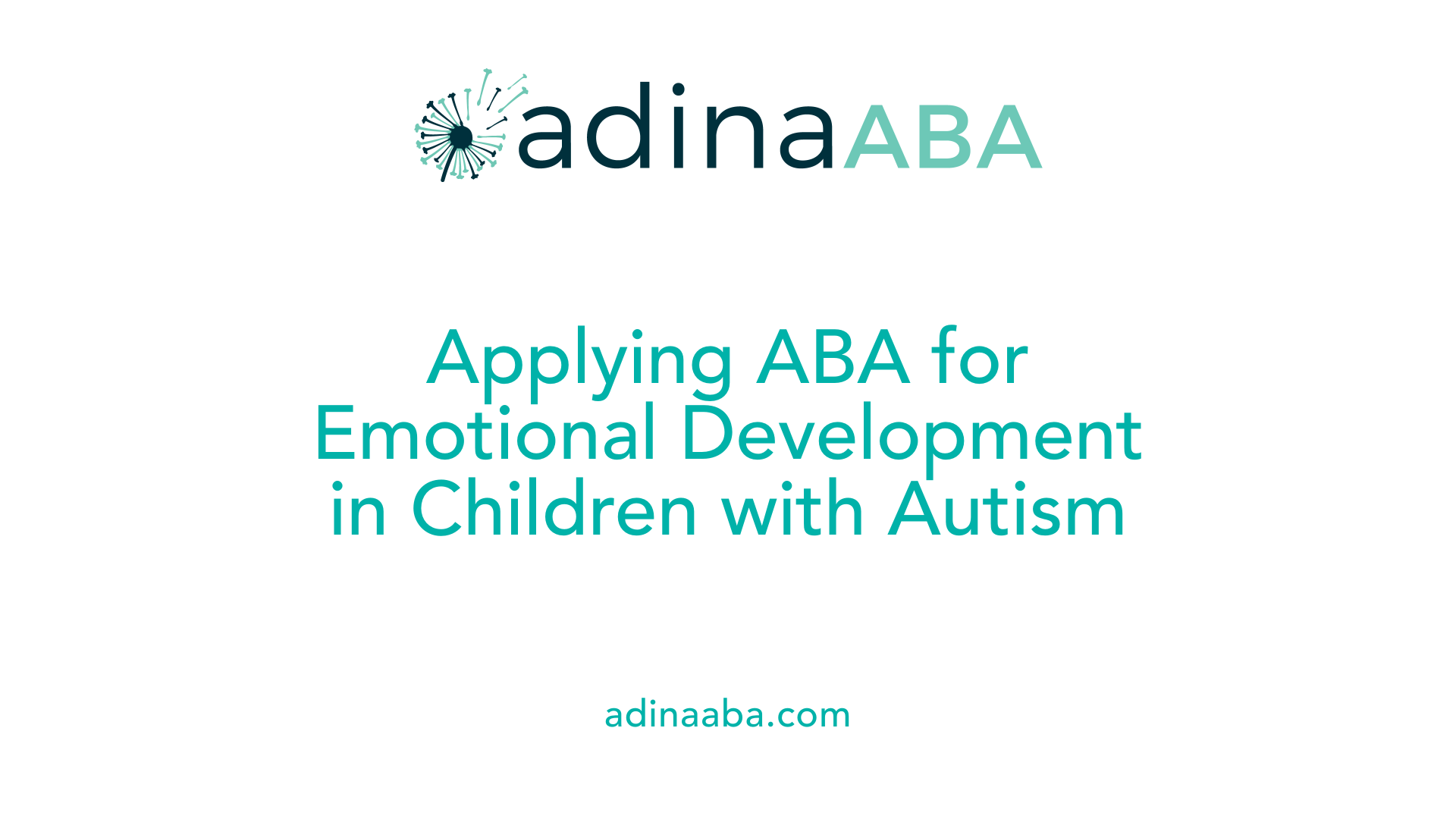Using ABA to build emotional vocabulary

Understanding the Power of ABA in Emotional Development
Applied Behavior Analysis (ABA) has long been a cornerstone in supporting children with autism, but its benefits extend beyond behavior modification. When tailored effectively, ABA techniques can play a significant role in developing a child's emotional vocabulary, thereby enhancing overall emotional intelligence, social skills, and mental well-being. This article explores how ABA can be leveraged to teach, reinforce, and generalize emotional understanding in children, including those on the autism spectrum.
Using Visual Supports and Reinforcement in ABA to Teach Emotional Vocabulary
 In Applied Behavior Analysis (ABA), teaching emotional vocabulary involves a combination of visual supports, reinforcement strategies, and creating an environment rich in emotional learning opportunities.
In Applied Behavior Analysis (ABA), teaching emotional vocabulary involves a combination of visual supports, reinforcement strategies, and creating an environment rich in emotional learning opportunities.
Visual aids such as emotion flashcards, charts, and pictures are fundamental tools. These visuals depict a wide range of facial expressions and emotional states, helping children recognize and identify feelings like happiness, worry, excitement, or fear. Repeated exposure to these materials allows children to build a robust emotional vocabulary, making it easier for them to articulate their feelings.
Reinforcement strategies are essential in consolidating learning. Modeling involves demonstrating appropriate emotional responses, showing children how to verbalize their feelings in different situations. Prompting provides cues or hints to guide children in labeling emotions correctly. Differential reinforcement rewards the correct identification of emotions, encouraging children to use their new vocabulary consistently.
Creating an emotion-rich environment supports ongoing emotional understanding. This can include daily routines such as morning reviews or bedtime reflections, where children are encouraged to talk about their feelings. Incorporating activities like emotion charades or storytelling engages children actively, promoting deeper comprehension.
Other techniques include incorporating calming strategies, such as deep breathing or sensory tools, to help children regulate their emotions. This regulation experience reinforces their ability to identify feelings accurately and respond appropriately.
Data collection is vital for tracking progress and ensuring skills generalize across settings, whether at home, school, or community environments. Over time, these approaches help children develop a more extensive emotional vocabulary and better emotional regulation, laying the foundation for healthier social interactions and communication skills.
In summary, ABA techniques utilize visual supports and reinforcement to systematically teach children emotional vocabulary, fostering emotional awareness, regulation, and social competence.
Applying ABA Principles for Emotional Growth in Children with Autism

How can ABA principles be applied to support emotional development in children, including those with autism?
Applied Behavior Analysis (ABA) offers effective strategies to nurture emotional skills in children with autism. These principles focus on structured, consistent teaching methods that help children recognize, understand, and express their feelings.
A cornerstone of ABA is creating a predictable environment through routines and visual supports, which provide a sense of security and clarity. For example, visual emotion flashcards and social stories help children identify and understand different feelings, making abstract concepts concrete and manageable.
Using reinforcement techniques, such as praise or preferred activities, encourages children to practice emotional expression and regulation. Breaking down complex social behaviors into small, manageable steps and modeling appropriate responses with videos or role-playing improves their ability to navigate social interactions.
Collaboration with caregivers and therapists ensures that learning is consistent and generalized across different settings, promoting continuous emotional development. Regularly celebrating small successes and setting realistic goals motivate children and bolster their confidence.
Incorporating play and positive interactions into learning routines can further develop emotional resilience. Overall, applying ABA strategies enables children with autism to enhance their emotional understanding and regulation, leading to healthier social and personal growth.
Strategies and Methods for Teaching Emotional Vocabulary Using ABA

What strategies and methods are effective for teaching emotional vocabulary using ABA?
Applied Behavior Analysis (ABA) offers structured and evidence-based approaches to help children develop their emotional vocabulary, which is vital for emotional intelligence and regulation.
Visual supports are fundamental in ABA education. Tools like emotion flashcards and feelings charts visually depict various emotions, enabling children to identify, label, and understand their feelings more easily. For example, using a feelings chart with pictorial representations helps children recognize emotions like happiness, sadness, or anger, reinforcing their emotional recognition skills.
Modeling plays a significant role. Demonstrating how to label and talk about feelings encourages children to imitate these behaviors. Alongside modeling, discrete trial teaching (DTT) and behavior skills training (BST) break down emotional recognition into smaller, manageable steps. Instruction, rehearsal, and feedback are repeated until the child can independently identify and name emotions.
Incorporating experiential learning activities, such as social stories and role-playing exercises, allows children to practice emotional recognition in real-life scenarios. Video modeling can also be used to demonstrate appropriate emotional expression and understanding, providing a dynamic and engaging learning experience.
Reinforcing calm and appropriate emotional responses is essential. Using positive reinforcement for successful emotional regulation and labeling helps solidify these behaviors. Consistent reinforcement encourages children to develop self-control and better emotional management.
Finally, personalized data collection is crucial to ensure interventions are tailored to each child's specific needs. Tracking triggers, responses, and progress allows educators and therapists to adjust strategies timely and effectively.
In summary, combining visual supports, modeling, experiential activities, reinforcement, and individualized data collection aligns with ABA principles, effectively enhancing children’s emotional vocabulary and their overall emotional skills.
Benefits of Using ABA to Enhance Children's Emotional Vocabulary

What are the benefits of using ABA to enhance emotional vocabulary in children?
Applied Behavior Analysis (ABA) provides a structured approach to helping children develop a richer emotional vocabulary. It is particularly effective for children with developmental needs, including autism, who often struggle with recognizing and expressing emotions.
ABA uses visual aids like emotion flashcards to assist children in identifying and labeling various feelings such as happiness, worry, and fear. These tools make abstract concepts more tangible, facilitating better understanding.
Incorporating play-based activities and social scenarios through ABA strategies allows children to practice recognizing emotions in real-life contexts. Techniques like discrete trial training support gradual skill building, promoting clear verbal communication about feelings.
Positive reinforcement encourages children to use their new vocabulary, improving their ability to articulate emotional experiences. This not only boosts communication but also enhances social interactions.
Moreover, ABA helps children interpret non-verbal cues, such as facial expressions and body language, which are crucial for understanding others' emotions. This skill improves their social competence and reduces misunderstandings.
Overall, ABA interventions foster emotional regulation, decrease problematic behaviors linked to emotional confusion, and support better mental health and social functioning, laying a foundation for success in school and beyond.
Educational Resources and Tools for Developing Emotional Recognition Skills
Supporting children and adolescents in developing their emotional awareness can be effectively achieved through a variety of educational resources and tools. Visual aids like emotion flashcards and charts serve as fundamental tools, illustrating a broad spectrum of feelings beyond basic emotions such as happiness, sadness, or anger. Emotion wheels, blob trees, and emotion charts help learners identify, label, and understand their feelings in a concrete way.
Storybooks that focus on emotions, combined with discussion prompts, offer relatable scenarios that promote empathy and emotional understanding. These stories encourage children to recognize feelings in characters and relate them to their own experiences, fostering a deeper connection to emotional vocabulary.
Classroom strategies like establishing peace corners, practicing mindfulness, and implementing social-emotional curricula such as The Zones of Regulation or programs aligned with CASEL standards further support emotional literacy. These approaches enhance self-awareness and regulation skills, providing a structured environment where children can learn to manage their feelings.
Interactive digital tools, including apps designed for emotional learning and educational games, make recognizing and managing emotions engaging and accessible. Mood meters and emotion toolbars are practical instruments that help children track their emotional states throughout the day, promoting ongoing self-awareness.
By integrating these resources into daily routines—such as morning check-ins, snack times, or bedtime reflections—educators and parents can foster an environment conducive to emotional development. The varied use of visual, literary, and technological tools ensures that emotional recognition skills are built effectively across different learning styles and age groups.
| Resource Type | Examples | Purpose |
|---|---|---|
| Visual aids | Emotion flashcards, charts, wheels | Expand emotional vocabulary, recognize feelings |
| Literature and discussion prompts | Emotion-focused storybooks and activities | Promote understanding and labeling of emotions |
| Classroom strategies | Peace corners, mindfulness exercises | Support self-awareness, emotional regulation |
| Digital tools | Apps, mood meters, emotion toolbars | Engage students in ongoing emotional tracking |
| Interactive activities | Emotion charades, role-playing | Foster active understanding and expression of feelings |
The Importance of Developing Emotional Skills for Lifelong Success and Social Harmony
Impact on emotional intelligence and relationships
Developing a strong emotional vocabulary helps children understand and express their feelings clearly. This foundation enhances their emotional intelligence, which involves recognizing, understanding, and managing emotions. When children can articulate their frustrations or concerns, they navigate social interactions more smoothly, resulting in healthier relationships with peers, teachers, and family members.
Role in conflict resolution and mental health
A well-developed emotional vocabulary enables children to handle disagreements peacefully by verbalizing issues instead of acting out. This skill reduces behavioral problems and supports mental well-being by lowering anxiety and stress. As children learn to talk about their feelings, they build resilience, which benefits them throughout their lives.
Support for personal and professional growth
Expressing thoughts clearly boost self-esteem, confidence, and self-worth—traits that persist into adulthood. Additionally, encouraging children to articulate problems promotes critical thinking and problem-solving abilities, essential for personal development and leadership roles later in life.
Special considerations for children with autism
For children with autism, developing emotional skills might be more challenging because they often struggle to identify and interpret feelings. Using tools such as emotion flashcards, storytelling, and role-playing can help expand their emotional vocabulary. Personalized learning activities make emotional recognition and expression more engaging, supporting their social and personal growth.
| Aspect | Benefits | Methods for Development |
|---|---|---|
| Emotional vocabulary | Better emotional understanding | Using emotion flashcards, storytelling |
| Conflict resolution | Peaceful dispute management | Role-playing, matching games |
| Social skills | Improved friendships and teamwork | Interactive activities, tailored learning |
| Mental health | Reduced anxiety and stress | Expressing feelings regularly, mindfulness practices |
| Autism support | Enhanced communication and empathy | Visual tools, personalized routines |
Cultivating Emotional Competence with ABA
Integrating ABA strategies into emotional literacy development provides a comprehensive framework for helping children recognize, understand, and regulate emotions. By leveraging visual supports, reinforcement, role-playing, and consistent routines, caregivers and educators can promote meaningful emotional growth that supports healthier social interactions, reduces behavioral issues, and lays a foundation for lifelong emotional intelligence and success. Whether working with children on the autism spectrum or neurotypical learners, ABA offers adaptable, evidence-based methods that foster resilience, confidence, and empathy—cornerstones of personal and social well-being.
References
- Helping Our Children Build a Strong Emotional Vocabulary
- Using Emotions Flashcards for Autism Support - Hello ABA Therapy
- 8 Simple Strategies to Increase Emotional Vocabulary - Brookes Blog
- How emotional intelligence makes you a better lawyer
- Teaching Kids to Identify Their Emotions with ABA
- Teaching Emotional Regulation in Autistic Children - Childwise ABA
- What is Emotional Regulation? Breaking Down the Basics for ABA ...
More Resources
Expert Clinicians
Get started today ->


.jpg)
.jpg)
.jpg)

.jpg)